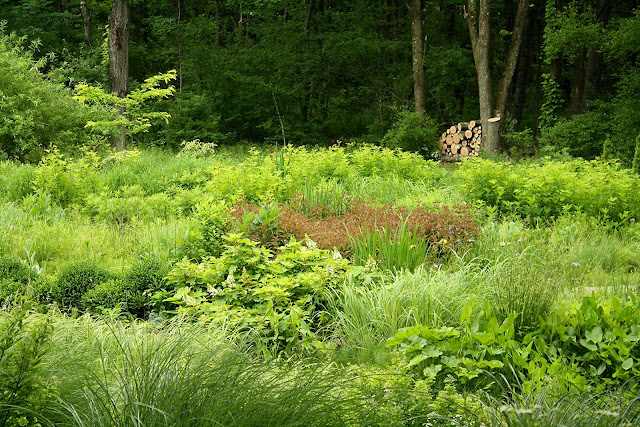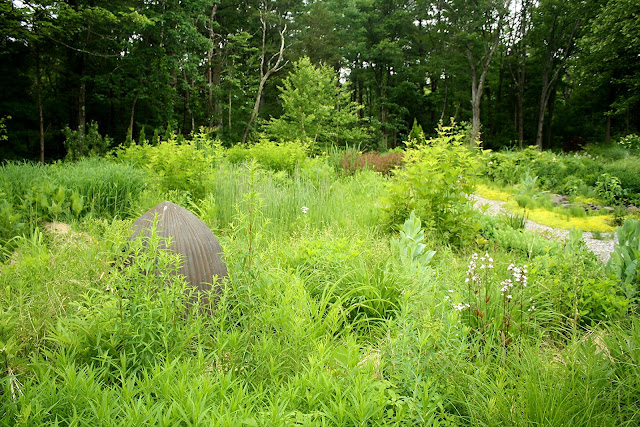Plants for shade on the left, plants for sun on the right. Trying to keep the two different communities in balance visually is the challenge. In such a small space, the idea is to plant with enough variety to give interest through all seasons while maintaining a unified, cohesive design--an impression of simplicity, a feeling of tranquility. One key to planting in such a garden is layering--planting at low, medium, and higher levels to completely cover the ground, and create interest in limited space.
 |
| Too many evergreen balls? Those yews at back will eventually form a linear hedge, and the ball effect should disappear. |
The shade side is much more fully planted, though a close look shows plenty of room for more use of layering. That requires careful selection of plants with similar cultural requirements, and with complementary shapes, colors, and textures. I think I'm well along on the road to success, but I won't really know until next year when I can see how the vegetation is spreading and knitting together. Editing and changes in placement will be inevitable.

I've been gathering plants for the sunny side for a couple of weeks. The sun is intense on this side, so I'm using plants that I know can endure the stress, mainly grasses and sedums, with a mixture of other durable perennials I like--Pycnantheum muticum (mountain mint), bronze fennel, sedum 'Autumn Joy' (for color and texture, but mostly great structure through winter) and Vera Jamison, Ceratostigma plumbaginoides (blue flowers, red autumn color, and a creeping, drooping habit), the Japanese rice paper plant Tetrapanax 'Steroidal giant' (to give height and big, bold foliage, should it survive our winters), and under it Rodgersia podophylla 'Braunlab', one of the rodgersias with a wider, more geometric leaf shape. This combination will only work if the Tetrapanax grows tall and the Rodgersia mounds below it and, even then, the two strong foliage forms may clash.
I've also used some small grasses--Sporobolis heterolepis and Pennisetum 'Hameln' as well as one tall grass that's proven of great value in the Federal Twist garden, Panicum 'Cloud Nine', which develops a delicate, airy cloud of flowers in late fall that belies its strength and durability. It also colors a beautiful yellow.

Many of these plants also act as ground covers, thus obviating need
for layering, but you can see from the open ground there's lots of
opportunity for layering in other areas and I need to find compatible
plants for that. One I've used is a dark, almost black, Ajuga 'Black
Scallop'. I'll continue my regular visits to local nurseries to find
others.
My major reservation about this planting is its bluish cast,
especially compared to the intense greens on the shade side, which are dramatic and sculptural against the dark wall of fencing, and its whispy, insubstantial forms. But I'll
live with this for a while before making a final decision on possible
changes.
Below, the view from the back. Excuse the clutter, but this is a garden-in-progress. That small stone this side of the pool has been removed, and I'm considering using larger stones at the far end of the pool. These shapes are almost ideal to my eye but I think bigger might be better. I've also speculated whether I could add a couple of Darmera peltata on the sunny side (left) as a "linking" plant. Can it take the heat?
The planting of sedum and hens and chicks. Other great plants for layering, though used alone here.
To finish, some examples of layering, up close ...
Because space is tight, small plants dominate. I'm a lover of giant plants, so this new garden requires a major shift in design approach for me. I've been surprised how easy it's been.
The prize for small plants without a doubt goes to Cornus canadensis in the middle of the photo below.
This plant, known for being difficult to establish, languished in small pots for weeks in my garden, drying out several times, but sprang to life as soon as I put it in soil. I find its leaf veining and tiered structure delightful ...
... so I'm off to
Paxson Hill Farm this weekend to see if they have any left.

























































